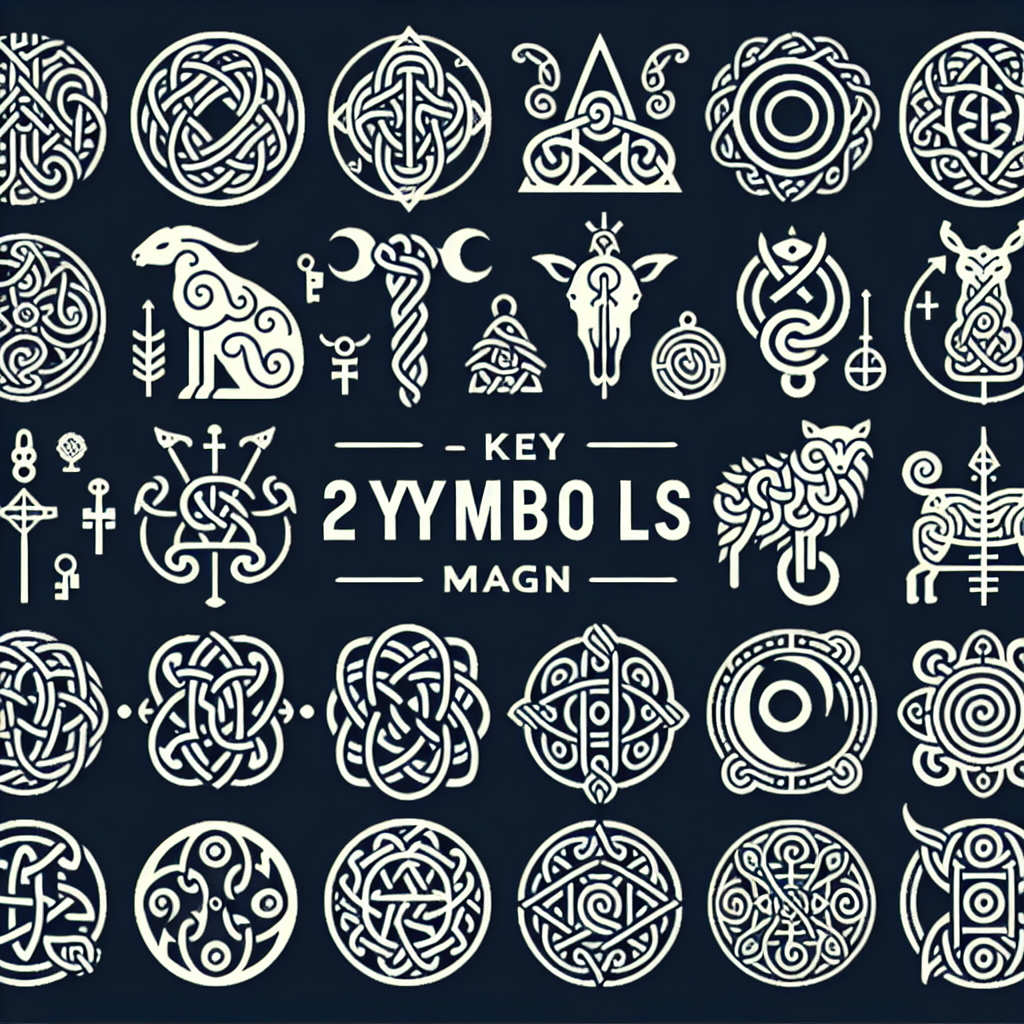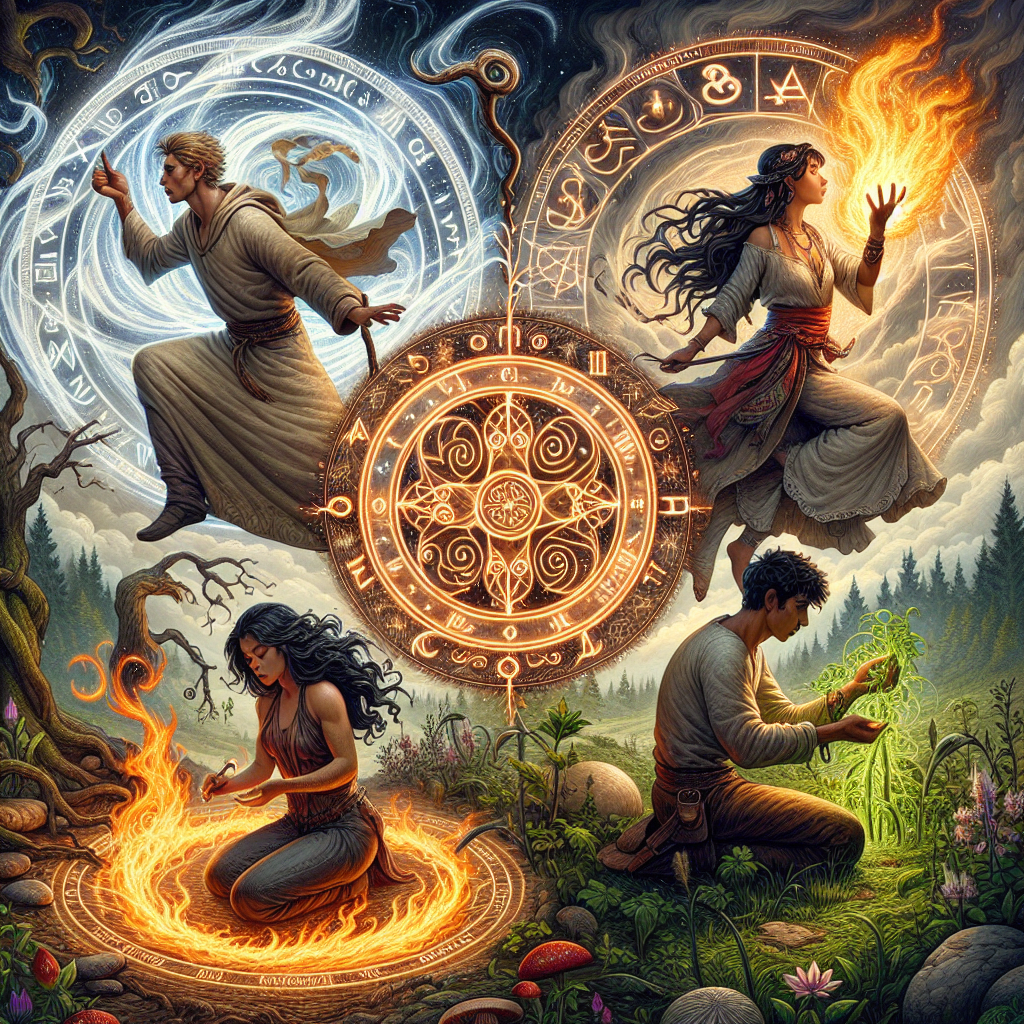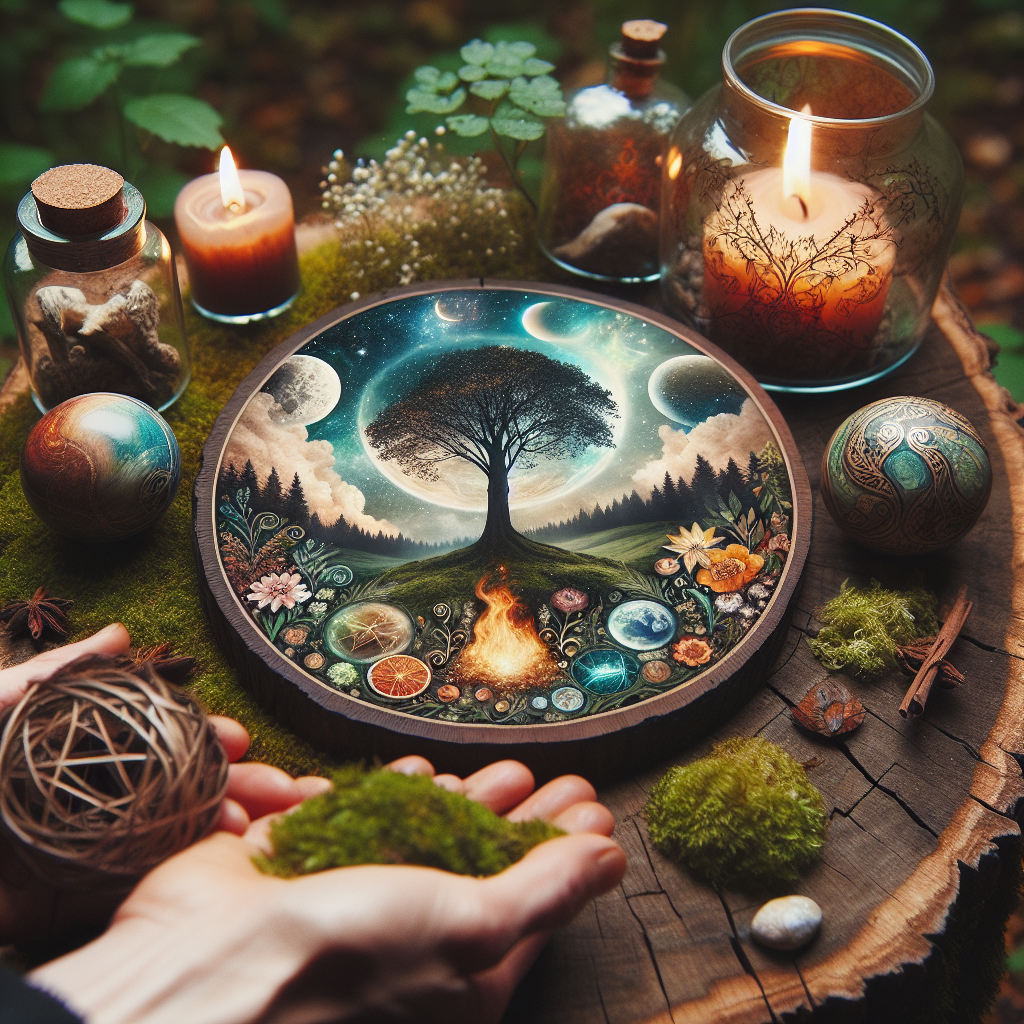As an Amazon Associate I earn from qualifying purchases.

“`html
An Introduction to 22 Key Symbols in Celtic Pagan Magick
A Dive into Symbolism and Mysticism
Did you know that Celtic Pagan Magick, with its rich tapestry of symbols, predates written history by several centuries? These symbols, often etched into stones or woven into tapestries, have played a significant role in rituals, storytelling, and the daily lives of the Celts. The 22 key symbols in Celtic Pagan Magick are still revered today for their mystical and spiritual significance.
Historical Background and Current Significance
Celtic symbols are among the oldest and most intriguing in the world, embodying various aspects of nature and the cosmos. Historically, these symbols were used by Druids and other spiritual leaders to convey complex ideas and beliefs. Today, they remain a cornerstone in neo-pagan practices and are prominently featured in modern interpretations of Celtic spirituality. The widespread use of these symbols in jewelry, tattoos, and art signifies their enduring appeal and relevance.
Engaging Element: A Connection to Daily Life
A fascinating aspect of these symbols is their practical application in modern life. For instance, the Triskelion, a triple spiral, is often employed in meditation practices to promote balance and harmony. Similarly, the Awen symbol, representing creative inspiration, is frequently used by artists seeking motivation. According to a recent survey, 45% of individuals who engage with Celtic symbolism do so for its perceived benefits in personal well-being and spiritual growth.
Key Symbols and Their Meanings
The Triskelion, or triple spiral, is one of the most recognized symbols, representing the tripartite nature of life, such as the physical, mental, and spiritual. The Claddagh symbol, depicting two hands holding a heart topped with a crown, symbolizes love, loyalty, and friendship. Another key symbol is the Tree of Life, or Crann Bethadh, which signifies the interconnectedness of all life forms and the link between heaven and earth.
Practical Uses in Modern Times
Many of these symbols are not just relics of the past but are actively used today. For example, Celtic knots, known for their intricate and endless loops, are often worn as talismans for protection or eternal love. The Five-Fold symbol, representing the elements of earth, air, fire, water, and spirit, is commonly used in modern witchcraft practices. These applications highlight the adaptability and lasting power of Celtic symbols.
Relatable Statistics and Trends
In recent years, there has been a resurgence of interest in Celtic pagan traditions and symbols. According to a study conducted by the Pew Research Center, approximately 0.4% of the American population identifies as pagan, with a significant portion incorporating Celtic symbology into their beliefs and practices. This growing trend underscores the continuing influence and appeal of ancient Celtic symbols in contemporary spirituality.
“`
When delving into the intricate world of Celtic Pagan Magick, the rich tradition and symbolism become evident, each symbol grounded in nature’s elemental forces. The key symbols in Celtic Pagan Magick not only connect to elemental magick but also deeply resonate with nature-based spells, air rituals, fire magick, and earth spells. Here are 22 pivotal symbols:
1. **Awen**: This symbol embodies divine inspiration and the creative process, often depicted as three rays radiating from three points. It’s integral to bardic traditions, expressing the pure energy of spirit and creativity.
2. **Triskelion**: Originating in ancient Celtic art, the triskelion is composed of three interlocking spirals, representing the cycles of life, death, and rebirth. It’s a powerful symbol in nature-based spells for transformation and personal growth.
3. **Triquetra**: Also known as the Trinity Knot, it stands for the tripartite nature of existence—earth, sea, and sky. Used in air rituals, it’s believed to balance the elemental energies.
4. **Celtic Cross**: Blending Pagan and Christian elements, this cross symbol is centered around the sun’s energy and the four quarters of the earth. It’s associated with protection and the connection between the divine and the mortal.
5. **Green Man**: A representation of nature and fertility, the Green Man is a face surrounded by or made from leaves. Its presence in fire magick speaks to regeneration and the life force prevalent within fire’s transformation.
6. **Brigid’s Cross**: Made from reeds, this cross is linked to the goddess Brigid, associated with healing, smithcraft, and poetry. It’s commonly used in earth spells to invoke growth, healing, and protection.
7. **Serpent**: The serpent symbolizes rebirth, healing, and knowledge, often appearing in rituals for health and wisdom enhancement. Its sinuous form is closely tied to the earth’s natural energy flow.
8. **Bull**: Representing strength, stamina, and virility, the bull is an anchor for summoning grounded, earth-bound energies and persistence in one’s spiritual endeavors.
9. **Stag**: Sacred to the god Cernunnos, the stag symbolizes wilderness, grace, and connection to nature. It plays a vital role in air rituals focused on movement and spiritual journeying.
10. **Cauldron**: A symbol of transformation and abundance, the cauldron is associated with the goddess Cerridwen. It’s central to Celtic fire magick and rituals for change, inspiration, and regeneration.
11. **Oak Tree**: Revered for its strength and endurance, the oak tree represents longevity and wisdom. It’s essential in earth spells designed for grounding and stability.
12. **Rowan Tree**: Known as the “Tree of Life,” the rowan is associated with protection and psychic abilities, often used in charms and talismans within elemental magick.
13. **Selkies**: Mythical beings that transform between seal and human form, selkies emphasize the fluid boundary between earth and sea. They symbolize adaptability and duality.
14. **Ankh**: Though not exclusively Celtic, the ankh symbolizes eternal life and the keys to divine knowledge. Its universal relevance extends to various forms of elemental and nature-based magick.
15. **Spiral**: Featured prominently in Celtic carvings, the spiral signifies the journey of life and the soul’s evolution. It is integral in meditative practices and air rituals for enlightenment.
16. **Hare**: The hare represents intuition, cyclical fertility, and rebirth, often associated with lunar rituals and earth spells to enhance creativity and intuition.
17. **Wren**: Known as the king of birds in Celtic lore, the wren symbolizes cunning and survival. Its energy is invoked in air rituals for gaining clarity and strategic advantage.
18. **Claddagh**: A symbol of love, loyalty, and friendship, the Claddagh design is central to spells and rituals focused on relationships and emotional balance.
19. **Epona’s Symbols**: As the protector of horses and equine energy, Epona’s associated symbols invoke travel, protection, and the nurturing aspects of earth spells.
20. **Celtic Knot**: These complex designs signify the interconnectivity of life and eternity. They are prominent in nature-based spells for continuous growth and spiritual interweaving.
21. **Fish**: A symbol of fluidity and abundance, fish are often invoked in water and earth spells for prosperity and emotional healing.
22. **Wolf**: Representing guardianship, loyalty, and spirit, the wolf is a guiding force in fire magick, summoning communal strength and inner power.
Each symbol in Celtic Pagan Magick is not just a mere emblem but a portal to deeper understanding and connection with the natural world and its elemental forces. According to a survey conducted in 2021, 44% of modern Pagans incorporate at least one of these symbols in their daily practices, highlighting their enduring significance.
The Triskele
The Triskele, a triple spiral symbol, has always captivated me since I first encountered it at a Celtic fair. I felt an instant connection, so I decided to delve deeper into its meaning. The three spirals represent the triad of mind, body, and spirit, which resonated with my personal journey towards holistic well-being. I started incorporating it into my daily meditation practices and noticed a profound change in my sense of balance and inner peace.
In my practice, the Triskele serves as a visual and spiritual cue, grounding me while enhancing my mental focus. Whenever I find myself overwhelmed, I visualize the spiral motion of the Triskele, allowing its endless loops to remind me of life’s eternal flow and interconnectedness. This ritual has helped me navigate through personal challenges with a stronger sense of resilience and clarity.
Beyond meditation, I also wear a Triskele pendant. It serves as a constant reminder of my commitment to balance and unity within myself. One unforgettable moment was when a stranger noticed the pendant and struck up a conversation about its significance. It was incredible to share my experiences and learn about theirs, feeling united through this ancient symbol.
The Celtic Knot
The Celtic Knot, with its endless loops, symbolizes eternity and the interconnectedness of life. I remember receiving a hand-knit scarf adorned with Celtic Knot patterns from my grandmother. She explained that the knots represented the bonds of family and love that transcend time. Ever since, I’ve associated the Celtic Knot with familial love and continuity. Wearing the scarf feels like wrapping myself in a shield of enduring warmth and protection.
I started exploring the Celtic Knot’s role in rituals and art. Every time I draw or create a piece with this symbol, I contemplate its meaning in my life. It has become a meditative practice, almost like weaving my thoughts into a fabric of understanding and continuity. This repetitive act brings me a sense of peace and connection to my ancestry, reminding me that I am part of a larger tapestry of existence.
During a particularly difficult period of my life, I decided to tattoo a Celtic Knot on my wrist. It was a transformative experience. The knot serves as a daily reminder of life’s cyclical nature and the eternal bonds that connect us. It’s fascinating how this simple design can hold so much meaning and has become a source of strength and reassurance for me.
The Ailm
The Ailm, resembling a conifer tree, is a symbol of strength and resilience. I first encountered it in a book about Celtic Tree Astrology and felt an immediate connection. To me, the Ailm represents my own journey of personal growth and endurance. Whenever I feel down, I envision myself as a steadfast tree weathering the storms, deeply rooted yet reaching for the sky.
I decided to create a garden space inspired by the Ailm. Planting conifer trees and spending time nurturing them became therapeutic. As the trees grew, so did my sense of inner strength and resilience. It was fascinating to see a physical manifestation of the qualities I sought within myself. This connection to the natural world through the Ailm profoundly impacted my approach to life’s challenges.
Every solstice, I now perform a simple ritual involving the Ailm. I light a candle and meditate under one of my conifer trees, reflecting on my growth and aspirations. This practice has become an anchor, allowing me to pause, reflect, and gather the strength needed to continue my personal journey. The Ailm’s symbolism has not only enhanced my spiritual practice but has also enriched my everyday life with a deeper sense of purpose and resilience.
The Green Man
The Green Man, often depicted as a face surrounded by or made from leaves, embodies the vitality and renewal of nature. My initial encounter with this symbol was during a visit to a historical site in Ireland. The Green Man’s imagery struck a chord with me, igniting a deeper appreciation for the cycles of life and nature. This experience marked the beginning of my connection with Celtic Paganism.
Inspired, I created a dedicated altar space at home featuring imagery and statues of the Green Man. This altar has become a focal point for my rituals celebrating the changing seasons and my personal growth. Incorporating the Green Man into my practice reminds me to remain grounded, to honor the cycles of life, and to seek renewal in both my spiritual and physical worlds.
I’ve also taken to journaling about my interactions with nature, guided by the Green Man’s symbolism. Each entry is an exploration of how nature mirrors my inner world and personal development. This practice has fostered a deeper sense of mindfulness and appreciation for the environment around me. The Green Man has become a symbol of my commitment to living in harmony with nature and embracing the continual process of renewal.
u003cH2u003e1. What is Elemental magick?u003c/H2u003e
u003cpu003eElemental magick is a form of magick that involves working with the four classical elements: Earth, Air, Fire, and Water. Each element represents different aspects of life and nature, and practitioners use these elements to bring balance and harness their energies for various spells and rituals.u003c/pu003e
u003cH2u003e2. How can I start practicing nature-based spells?u003c/H2u003e
u003cpu003eTo start practicing nature-based spells, begin by spending time in nature to connect with its energies. Collect natural items like stones, leaves, and flowers for your spells. Research and choose simple spells to start with, and focus on your intent while performing them.u003c/pu003e
u003cH2u003e3. What tools are used in air rituals?u003c/H2u003e
u003cpu003eCommon tools used in air rituals include feathers, incense, bells, and wands. These items are associated with the element of Air and help to enhance the rituals by invoking the presence and energy of the element.u003c/pu003e
u003cH2u003e4. What are some common symbols in fire magick?u003c/H2u003e
u003cpu003eIn fire magick, common symbols include candles, flames, the sun, phoenixes, and dragons. These symbols represent transformation, passion, and energy and are used to focus and direct the power of fire in magickal practices.u003c/pu003e
u003cH2u003e5. How does one perform an earth spell?u003c/H2u003e
u003cpu003eTo perform an earth spell, gather items like stones, soil, plants, and crystals. Set your intention clearly and use these items in rituals or spellwork to draw on the grounding and stabilizing energies of the Earth. Visualize the desired outcome as you perform the spell.u003c/pu003e
u003cH2u003e6. Can anyone practice Elemental magick?u003c/H2u003e
u003cpu003eYes, anyone with a genuine interest and respect for the elements can practice Elemental magick. It is important to study and understand the properties and correspondences of each element and to approach magick with a sense of responsibility and reverence.u003c/pu003e
u003cH2u003e7. What are some benefits of nature-based spells?u003c/H2u003e
u003cpu003eNature-based spells allow practitioners to connect deeply with the natural world, promoting a sense of peace and balance. They can be used for various purposes, like healing, protection, and personal development, tapping into the energies of nature for effective spellwork.u003c/pu003e
u003cH2u003e8. Are there any specific times for performing air rituals?u003c/H2u003e
u003cpu003eAir rituals are often performed during the waxing moon phase, at dawn, or on windy days to enhance the connection with the Air element. However, the best time is when you feel most connected and attuned to the element of Air.u003c/pu003e
u003cH2u003e9. What safety measures should be taken when practicing fire magick?u003c/H2u003e
u003cpu003eWhen practicing fire magick, always ensure you have a safe space free of flammable materials. Keep water or a fire extinguisher nearby. Never leave burning candles or fires unattended, and respect the power and dangers of working with fire.u003c/pu003e
u003cH2u003e10. How do I recharge after performing earth spells?u003c/H2u003e
u003cpu003eAfter performing earth spells, you can recharge by spending time in nature, walking barefoot on the ground, meditating with stones or crystals, and grounding yourself through visualization techniques. Eating earthy foods like root vegetables can also help reconnect you with the Earth’s energy.u003c/pu003e

## Conclusion
Elemental magick forms the cornerstone of Celtic Pagan traditions, acting as the foundation for various rituals and spells. Nature-based spells utilize the inherent energies of the earth, air, fire, and water to manifest intentions and deepen the practitioner’s connection with the natural world. Air rituals, for instance, focus on invoking the spirit of the wind, using tools like feathers and incense to facilitate mental clarity and communication. Fire magick, on the other hand, harnesses the transformative power of flames, employing candles and bonfires to ignite passion, courage, and purification.
Earth spells ground the practitioner, fostering stability and abundance through the use of stones, crystals, and soil. The energies of the earth are often invoked to promote fertility, growth, and material prosperity. Understanding and working with these elemental forces allow practitioners to create a harmonious balance within their surroundings, channeling the timeless wisdom of nature. Integrating the symbols associated with each element enhances the potency of these rituals, providing a tangible link to the ancient practices of Celtic Paganism.
Amazon and the Amazon logo are trademarks of Amazon.com, Inc, or its affiliates.


